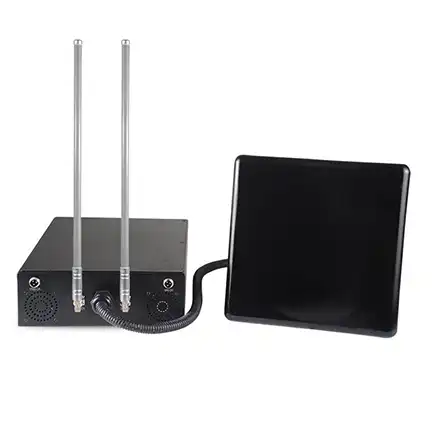When presenting your drone jammer to potential customers, the first question is always the same: "What is the range of your drone jammer gun?"
Unfortunately, most customers are familiar with communication links and devices, but know little about jamming concepts and devices. Therefore, they do not understand why there is no "simple" or single answer to this question.
The purpose of this article is to explain how to perform range calculations and/or measurements of interference "links". Obviously, the jammer is not making a "connection" with the victim, but we can look at their interaction as if it were a normal communication link between two "partners."

In general, we can say that if the communication link has only one dimension to calculate (TX->RX), for interference cases, two dimensions (TX->RX and Jammer->RX) need to be calculated and then compared. The "link" that will present a stronger signal at the receiver input will prevail; This can be a transmitter (" partner ") or a signal jammers.
In order to better explain the problem, we will first try to explain the basic concept of communication interference.
Jammers work by interrupting the communication link (or network) between two (or more) "partners" when they try to talk to each other or pass some data between them. Jamming the communication link between a drone and its operator is a special case among many others; We can try to jam the communication between the phone and the base, between two tactical radios, between the bomb and the remote control used to activate it, and so on.
To jam, the jammer transmits RF power at the same frequency used by the enemy link or network (CW + modulation). The enemy's receiver (the "listening" side) will receive both the jammer's transmission and that of its "partner." The strong will win; If the power of the jammer is greater than the power of the "partner", the "listener" will not be able to "understand" the message/data correctly. Alternatively, if the power of the "partner" is greater than the power of the jammer, the "listener" will most likely be able to "understand" the message/data correctly, and the communication link between the "partners" will continue uninterrupted.
This explanation is a bit superficial and aims to simplify things. However, if we try to "dig" deeper into the problem, we can use more parameters to compare two "linked" signal levels. An example is the SNR(signal-to-noise ratio) that the receiver "sees" at its input. Sometimes, the interference signal reaching the receiver input may be lower than the communication signal (" partner ") and dominate. This happens because the receiver usually needs to have some "margin" between the two signals at its input in order to be able to interpret one of the signals (usually the stronger one). However, in advanced communication systems,